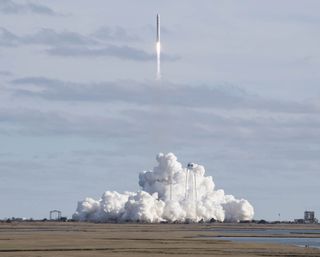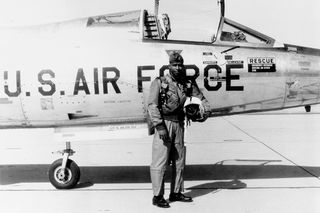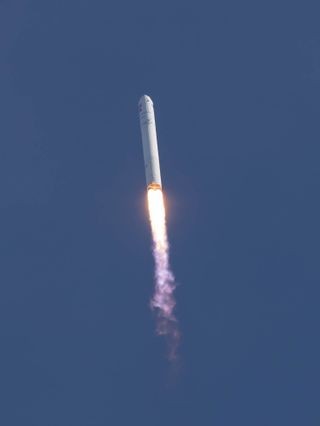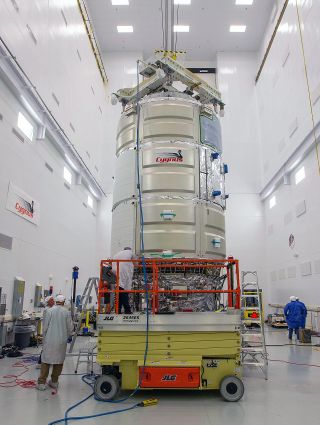Northrop Grumman launched a Cygnus spacecraft filled with NASA supplies (and some tasty treats) to the International Space Station Saturday (Feb. 15) in an afternoon liftoff that had some impeccable timing.
An Antares rocket (also built by Northrop Grumman) launched the uncrewed Cygnus NG-13 spacecraft at 3:21 p.m. EST (2043 GMT) — that's "3-2-1" for a liftoff time — from Pad-0A of the Mid-Atlantic Regional Spaceport at NASA's Wallops Flight Facility.
"Awesome launch today," Joel Montalbano, NASA's deputy program manager for the International Space Station, said just after launch during live commentary.
Related: Bacteria & bone: Here's the science launching on Cygnus NG-13
More: How Northrop Grumman's Antares rockets & Cygnus ships work
NASA initially tried to launch the mission on Sunday (Feb. 9), but aborted the attempt in the final minutes due to a ground equipment sensor glitch. Dismal weather throughout the week prompted more delays.

Cygnus NG-13 will arrive at the space station Tuesday (Feb. 18) deliver more than 7,500 lbs. (3,400 kilograms) of science experiments, supplies and other vital gear for the astronauts of Expedition 62. Packed among those supplies are some treats, including fresh fruit, choice candy selections just in time for Valentine's Day weekend, as well as and one extra special request from the astronauts.
"For the first time ever, we're sending some conditioned cheese in a small amount of space that we have left over," NASA's Ven Feng, manager of the International Space Station Transportation Integration Office, said in a press conference here on Saturday (Feb. 8).
The cargo ship is delivering wedges of Wisconsin cheddar, Parmesan and Fontina hard cheeses in a cold bag for the station's three-person Expedition 62 crew to enjoy. That crew includes commander Oleg Skripochka of Roscosmos and NASA astronauts Jessica Meir and Andrew Morgan.
Space pioneer honored

Northrop Grumman named the Cygnus NG-13 spacecraft the "S.S. Robert H. Lawrence" in honor of U.S. Air Force Maj. Robert H. Lawrence, Jr., who became the first African American ever selected to be an astronaut in 1967. The U.S. Air Force picked Lawrence as an astronaut for its Manned Orbiting Laboratory — a planned military space station — in June 1967, but he was killed in a training flight accident later that year before he could reach space.
Frank DeMauro, Northrop Grumman vice president and general manager for Tactical Space Systems, said Saturday that his team was honored to name Cygnus NG-13 in honor of Lawrence. The mission is launching during Black History Month, with NASA and others celebrating the contributions of African-American space pioneers.
"Although his career was cut short in a tragic accident, he paved the way for future aerospace pioneers of all races and enabled increased diversity and inclusion across the industry," DeMauro said Saturday. "While Major Lawrence never flew into space, we are proud that Cygnus will carry his name on this mission."
Related: Manned Orbiting Laboratory: Inside a US military space station

A science ride
Of the nearly 4 tons of cargo on Cygnus, 2,129 lbs. (966 kg) of it is made up of equipment for 20 different science experiments on the station. Those experiments include studies into bone loss from prolonged exposure to weightlessness, bacteria-targeting viruses that could lead to new medications, as well as some cowpeas to be grown as part of a space food experiment.
Heidi Parris, NASA's assistant program scientist for the International Space Station program's science office, said those experiments aim to use the weightless environment on the station to learn more about how to live off Earth, including on the moon and Mars.
"Taking that fundamental gravity out of the equation gives a fundamental understanding of how things work," Parris said.

One novel experiment is Mochii, a small scanning electron microscope about the size of a breadbox that can help astronauts quickly identify the composition of small particles, such as debris or contamination in spacesuits.
"Currently the ISS has a blind spot, in that we can't perform this kind of analysis on orbit," James Martinez, a materials scientist at NASA's Johnson Space Center participating in the experiment.
Mochii was built by the Seattle-based company Voxa. It will be installed in the station's Japanese Kibo laboratory and serve as a new platform and tool for astronauts and scientists.
"It's the first portable scanning electron microscope in the world," Christopher Own, Voxa CEO, said in a science briefing Saturday. And now, it's the first scanning electron microscope in space.
Another key experiment on Cygnus is the Spacecraft Fire Experiment IV, or Saffire-IV. As its name suggests, Saffire-IV is the fourth experiment to study how fire behaves in space aboard a Cygnus spacecraft after it leaves the space station.
Cygnus NG-13 is due to leave the station in May. Once it's a safe distance from the station, the fire experiment will be activated to see how materials like Nomex and plastic panels — which are used in spacesuits and spacecraft — burn inside a meter-long container.
"Fire safety has been a big concern ever since we started flying crewed vehicles into space," said Gary Ruff, Saffire-IV project manager at NASA's Glenn Research Center in Cleveland, Ohio. The new study will use high-speed cameras to capture different views of space under different oxygen levels, he added.
Related: Watch NASA's Fire-in-Space Experiments Ignite in a Blazing Success
Here's a breakdown of the cargo flying on Cygnus NG-13:
- Crew supplies: 1,570 lbs. (712 kg);
- Science gear: 2,129 lbs. (966 kg);
- Spacewalk equipment: 179 lbs. (81 kg);
- Vehicle hardware: 3,501 lbs. (1,588 kg);
- Computer resources: 66 lbs (30 kg).
A flock of Cygnus
Northrop Grumman's Cygnus is one of two private spacecraft (SpaceX's Dragon capsules are the other) that currently haul cargo to the International Space Station for NASA. NG-13 is the 13th Cygnus mission to reach space for NASA by Northrop Grumman as part of the agency's Commercial Resupply Services. That count doesn't include one failed launch in 2014.
On Jan. 31, Cygnus NG-13's predecessor NG-12 left the space station. Northrop Grumman launched the Cygnus NG-12 vehicle in early November while an even earlier vehicle, NG-11, was still in orbit. Friday's launch marks the second dual-Cygnus flight for Northrop Grumman.
Northrop Grumman's Cygnus NG-13 spacecraft will arrive at the International Space Station and be captured by a robotic arm on Tuesday, Feb. 18, at 4 a.m. EST (0900 GMT). NASA's live webcast of the rendezvous will begin at 2:30 a.m. EST (0730 GMT) and run through spacecraft capture. After a pause, NASA TV coverage will resume at 6 a.m. EST (1100 GMT) to show Cygnus NG-13's installation on the station.
Visit Space.com Tuesday for complete coverage of Cygnus NG-13's arrival and installation on the station.
Email Tariq Malik at tmalik@space.com or follow him @tariqjmalik. Follow us @Spacedotcom, Facebook and Instagram.
Bagikan Berita Ini














0 Response to "Northrop Grumman launches Cygnus cargo ship to space station for NASA - Space.com"
Post a Comment